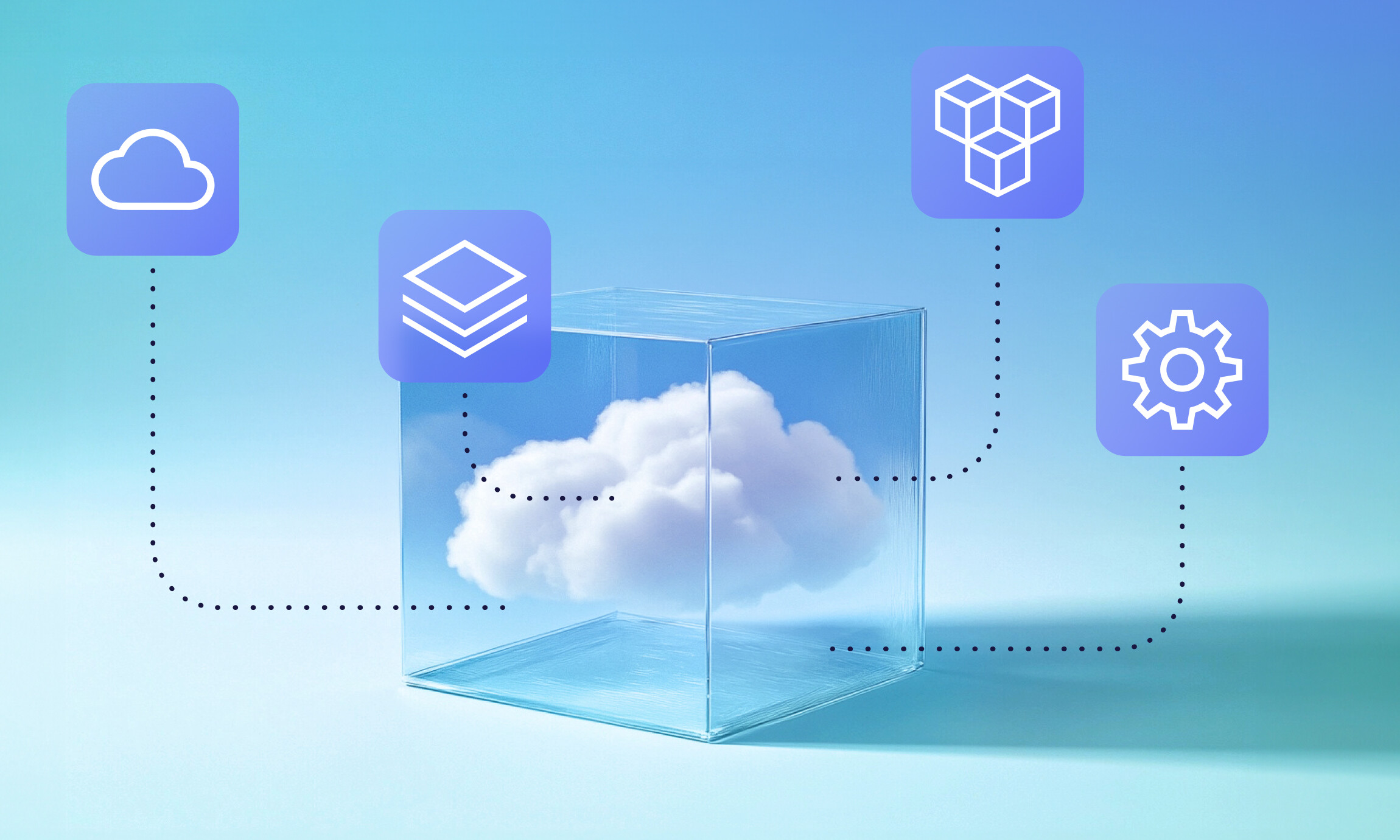
Composable commerce is widely viewed as a component-based solution that arose as a response to the shortcomings of monolithic platforms. Yet, this only tells part of the story. This is because, as composable commerce grows and evolves, it’s actually more than the sum of best-of-breed parts. In fact, for a composable solution to be truly and authentically composable, it needs to be cloud-native and tech-agnostic, too.
In this article, we zoom in on one of the core traits of a genuine composable commerce system: Cloud-native SaaS. Let’s explore what cloud-native is, the differences between cloud-native and cloud-hosted, and how leading businesses benefit from a true composable infrastructure with commercetools.

What’s cloud-native SaaS?
Cloud-native SaaS is a modern approach to building and running software applications in the cloud. It allows businesses to scale online capacity automatically by leveraging the flexibility, scalability and resilience of cloud computing. As software/SaaS that runs in the cloud, all functionalities are natively integrated with core components of cloud providers, such as Google Cloud and Amazon Web Services (AWS).
In business terms, cloud-native SaaS is one of the elements behind the scenes that enable companies to scale commerce capacity at speed (say, during Black Friday) without having to provision hardware and software internally. Businesses can outsource the heavy lifting of data center operations to a cloud provider, capitalizing on auto-scaling, high availability, reliability and security, as well as the agility of distributed architecture across the globe to support agile development, innovation and more.
Why is cloud-native SaaS essential for composable commerce?
As composable commerce combines independent and interchangeable components to build and run unique customer experiences, it’s the underlying cloud-native infrastructure that enables these independent components (such as carts, orders, promotions, etc.) to be deployed separately and scaled independently. That way, your business can meet changing customer demand and manage fluctuations.
For example, a business might need to scale its checkout functionality to meet a high customer influx. If the component is just hosted on the cloud or managed on-premise, it may face difficulties responding to a Black Friday-like traffic spike, thus facing slowdowns or even downtime.
In short, simply having independent and interchangeable components isn’t enough for your tech stack to be composable: It also needs to be cloud-native to scale and grow according to your customer demand — and your business needs.
How does cloud-native compare to similar terms?
In the cloud or on the cloud? Let’s unpack the cloudy differences.
While cloud computing is the combination of resources, infrastructure and tools provided on-demand by cloud providers, cloud-native is an approach that builds and runs software programs using the cloud computing model.
SaaS (software as a service) is how software is delivered to users and the cloud is the infrastructure through which it operates. Software as a service can be cloud-native, but not necessarily.
Cloud-native and multi-tenant architecture are complementary concepts that boost scalability with a single software instance and infrastructure to service multiple customers. These “tenants” use the same application or infrastructure while keeping data and operations distinct and secure.
As the name suggests, “cloud-hosted” are applications hosted on cloud infrastructure instead of on-premises servers. These applications are usually designed for on-premises environments and later migrated to the cloud, which often involves lifting and shifting existing applications to cloud servers without significant architectural changes, such as distributed and modular infrastructure.
A cloud-native application is inherently part of an ecosystem of microservices, container orchestrators and auto-scaling capabilities that enable companies to capitalize on the flexibility, resiliency and scalability of cloud computing from the get-go.
In other words, cloud-hosted applications (on the cloud) can’t fully benefit from the cloud-native architecture (in the cloud), such as faster time-to-market, fault isolation, etc.
What’s on-premise infrastructure and why are companies shifting to the cloud?
On-premise IT, commonly called “on-premise,” is situated within an enterprise's physical premises or hosted on servers in a remote facility. While enterprises have tighter control over their infrastructure, they lack the scalability for spontaneous and high-volume sales and the flexibility to create, adapt and customize commerce functions.
When businesses rely on these inflexible and unscalable infrastructures, they frequently face capacity constraints to meet online traffic peaks. In the on-premise world, it could take weeks or even months to order new servers, put them into a data center and provision them with all the necessary software to meet the capacity needed for a Black Friday-like event.
In such cases, companies simply guess their peaks and then multiply that by five to size their production environments. Hardware is statically deployed, sitting idle except for the few hours of the year when it spikes to accommodate seasonality periods. Not only does this require meticulous planning months in advance, but the hosting and maintenance costs bloat the IT budget.
While cloud-hosted solutions are a first step away from the inflexible on-prem infrastructures, they aren’t able to reap the benefits of cloud-native.
What are the benefits of cloud-native SaaS?
A cloud-native infrastructure enables companies to move away from rigid technology setups to a more airy and lightweight architecture, so they’re able to scale faster, innovate more, and become more adaptable and cost-efficient. In a nutshell, cloud-native SaaS provides the following top six benefits for businesses:
Infinite scale powered by elastic cloud access that’s automatically scaled without the need to order new servers or meticulously plan online capacity to meet Black Friday-like events.
Serving multiple locales worldwide requires an infrastructure that enables fast response times. If a business is based in Europe but wants to target audiences in the US and APAC, a cloud-native infrastructure provides a better option to reduce latency and response times.
Faster time to market enabled by agile practices, such as DevOps and continuous integration/continuous delivery (CI/CD). Developers can build and release applications rapidly.
Maximum flexibility and agility. As a modular, distributed and containerized infrastructure, adding or replacing independent components makes it easier to keep up with market changes and new customer demands.
Truly modern infrastructure that performs the heavy lifting of data center operations like racking, stacking and powering servers. This allows you to focus on your customers and core business projects rather than on IT infrastructure, boosting efficiency, improving security and reducing costs.
An inherently resilient, redundant, fault-tolerant system that enables applications to automatically recover in case of hardware failures or disruptions, reducing the risk of data loss and minimizing downtime, ensuring uninterrupted customer service.
How does cloud-native SaaS auto-scale online capacity and performance?
Using a cloud-native architecture enables brands to auto-scale online capacity to meet traffic
spikes during high-demand seasonal events, such as Black Friday, as well as sudden sales surges, without performance issues or downtime. That means it’s possible to meet your online traffic demands, even when workloads are constantly changing, without manually provisioning capacity. Technically, this is achieved by:
Load balancing: Businesses have a single entry point that later transparently distributes the load across multiple data centers according to relevant geographical zones.
Auto-scaling: Managed Kubernetes in each cloud provider, such as Google Cloud and AWS enable autoscaling, dynamically providing more computing resources during a higher influx of traffic.
In short, cloud service providers provide a range of options for swiftly and efficiently scaling resources up and down. These options, such as auto-scaling, load balancing and elastic computing, empower enterprises to adapt their resource allocation dynamically based on their customers’ fluctuating demands.
How does cloud-native SaaS reduce total cost of ownership (TCO)?
Businesses relying on on-prem and even cloud-hosted solutions must predict their resource needs for relevant seasonal events well in advance. This often means investing in hardware utilized during that specific time, leaving it unused for the rest of the year. What’s more, on-premise solutions are notably more expensive, as they have to cover the installation and upkeep of a company’s own servers, hardware and software maintenance, as well as hiring IT staff to oversee the solution.
Cloud-native SaaS addresses these problems head-on with:
An elastic infrastructure allows you to scale capacity up and down according to customer demand. In other words, you’re not paying extra hardware, software, hosting and provisioning costs when you don’t need them.
As a multi-tenant solution, cloud-native SaaS enables companies to consume fewer resources, reducing costs. Because a multi-tenant system performs maintenance, you’re always up-to-date and don’t have to pay additional fees for updates or upgrades.
In short, access cloud-native solutions via the Internet and receive all maintenance and upgrades without the effort or cost of doing it in-house. Such a move to the cloud offers significantly lower TCO as you can invest in less hardware or software and don’t need a large IT team to manage internal infrastructure.
How secure is cloud-native SaaS?
Security is a major concern for businesses in digital commerce. Although on-premise solutions might appear more secure as they are hosted on the company’s own servers, they have inherent security risks. For instance, if the company’s servers are targeted and hacked, the entire eCommerce platform becomes vulnerable.
In contrast, cloud-native systems are hosted by third-party providers with a strong security focus and framework, which includes:
Substantial investments in encryption, access controls, backup and disaster recovery to safeguard clients’ data. The built-in security of the underlying cloud provider, such as access and data control, encryption, privacy, firewalls, anomaly detection and other protective measures, is leagues ahead of what traditional on-prem can deliver.
Cloud-native platforms perform regular updates to address potential vulnerabilities at a much faster pace than a standard company would.
The distributed nature of cloud-native solutions means that even if one component is compromised, it’s much harder for attackers to take the entire system down.
Compliance with regulations like GDPR, as well as essential certifications like ISO/IEC 27001 and SOC II.
Being multi-tenant ensures a high level of data separation, especially when data for each project is stored in a separate database. Projects are only accessible to the customer who created them, and complete isolation and segregation of persistent data are assured and regularly checked. In addition, cloud network setups can use automated code scans, security-relevant logs, and vault and credential rotation for extra protection.
What benefits have businesses gained from using commercetools’ cloud-native SaaS?
Businesses can tap into the benefits of cloud-native SaaS with commercetools on their cloud provider of choice, such as Google Cloud and Amazon Web Services (AWS) reaping the rewards of improved scalability, agility and reliability.
Ulta Beauty, one of the largest US retailers, modernized its eCommerce solution, taking advantage of cloud-native technology powered by Google Cloud. Now, Ulta Beauty is prepared to handle surges in traffic through auto-scaling while maintaining high-speed performance during the holiday shopping season.
With these changes [cloud-native commerce], we are ready for a holiday season that everyone — even those of us in IT — gets to enjoy. We’re positioned to continuously focus on new, better ways to serve our guests.
IT Architect, Ulta Beauty
These examples show how businesses can benefit from composable commerce based on cloud-native SaaS. But there’s more: With commercetools B2B and B2C Commerce available on the marketplaces of the top cloud providers, your business can unlock the power of composable commerce with ease and convenience.
Your cloud marketplace shortcuts:
Simplifying procurement and billing, accelerating deployment, and improving security and compliance are paramount for businesses to leverage cloud-native infrastructure. In addition to the ability to auto-scale capacity, the tenets of cloud-native infrastructure are essential for companies to scale not only capacity but also innovation and growth possibilities. Now, your business is poised to implement and scale composable commerce faster than ever.
